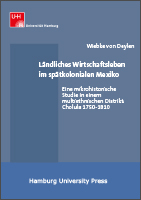Ländliches Wirtschaftsleben im spätkolonialen Mexiko. Eine mikrohistorische Studie in einem multiethnischen Distrikt: Cholula 1750-1810
Author(s)
Deylen, Wiebke von
Collection
AG UniversitätsverlageLanguage
GermanAbstract
In the late colonial period, the rural area of Central Mexico was characterized by haciendas, by Spanish-mestic small towns and by indigenous communities, which were defined and composed ethnically according to Spanish law. This study uses microhistorical methods to study the city of Cholula and its rural environment. The focus is on economic processes within the municipalities and interethnic exchange relationships at the individual level. The focus of the study is on Indian households and their scope for economic action. The analysis of the distribution of land ownership in Cholula already shows a high proportion of land ownership in private property, a result that fundamentally contradicts the previous knowledge about the organization of indigenous communities. Their role as a reservoir of labour for the haciendas is well known. This study shows that individual households also produced and marketed significant quantities of different agricultural and industrial products. The proof of the manifold inter-ethnic exchange relationships calls into question the relevance of the traditional description categories "Indian" and "Spanish" for the rural areas of Central Mexico and points out numerous parallels to European agricultural societies of the 18th century.
Keywords
Colonial period; Mexico; landownership; Cholula; Nahuas; agricultural history; inter-ethnic relations history 1750-1810; socio-economic changeDOI
10.15460/HUP.6ISBN
9783980822343OCN
1082948868Publisher
Hamburg University PressPublication date and place
Hamburg, 2003Classification
History


 Download
Download Web Shop
Web Shop